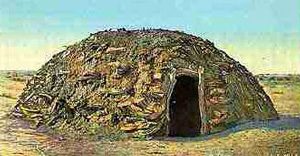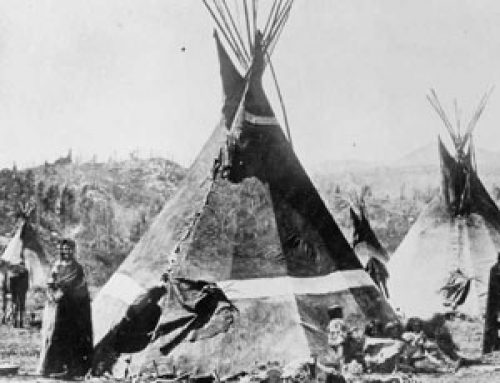
A Navajo hogan. Hogans had their doorways facing east
Early portable hogans
Early on, when Navajo people lived in the northern part of North America (modern Canada), they lived in small houses they called hogans. You built a hogan by propping a few poles together and covering the surface with branches, leaves, and mud.
Early Navajo people
History of houses
All our Native American articles
Later, sturdier hogans
But when the Navajo moved south and settled in the south-west part of North America about 1400 AD, they gradually settled down and began living in permanent houses so they could farm. They called these houses “hogans” too.
Late medieval timeline
The Little Ice Age

More Navajo hogans
You build a permanent hogan by laying wooden poles or logs on the ground, and then laying more poles on top of those poles, going around and around. When the walls are high enough you narrow them in to make a domed ceiling.
What is plaster?
What is half-timbering?
Then you plaster over the wood with mud to fill in all the spaces between the poles. This is something like the half-timbering medieval Europeans used at the same time, or like a round log cabin.
A Navajo hogan always faced east
Navajo people always built hogans with the door on the east side, so the morning sun would come into their house. Hogans had dirt floors and only one room. If people needed more room, they built more hogans near their first one, so that a Navajo home often had a bunch of hogans, one for each wife if there were several wives in the family, and maybe a sweathouse also (to get clean in, like our bathrooms), and separate buildings for storing things in (like our basements or attics).
Women’s hogans and men’s hogans
Most hogans were houses where kids lived with their mother and father. People called these houses “women’s hogans”. Men also built smaller hogans, called “men’s hogans”, which men used for religious ceremonies including ritual sweat baths (like Central Asian saunas). These hogans were built completely differently – more like the earlier traveling hogans.
You take three forked wooden sticks and stand them up so that their forks tangle together and they lean on each other like a tipi. Then you lean two more poles up against these to make the doorway. Then you lean up more poles all the way around to fill in the walls, and cover the whole thing with earth. So a “woman’s hogan” usually had horizontal logs in the walls, and a “men’s hogan” usually had vertical logs in the walls.
Native American food
Inside the hogan, women sat on the right, or the north side, where they kept their cooking things, and men sat on the left, or the south side. People slept on mats on the floor, with their feet toward the fire in the middle of the hogan.
Did you find out what you wanted to know about the Navajo hogan? Let us know in the comments!
Learn by doing: where do women sit in your house? Where do men sit?
Navajo architecture after the Spanish invaded
Bibliography and further reading about Navajo hogans:




Very Nice what I need to know is what do they use it for.
The Dine (the Navajo) used some hogans as houses, to live in, and others as baths, to get clean using a steam bath. And they used some hogans for religious rituals. Today, most Dine people use hogans mostly for religious rituals.
A sweat lodge is NOT like a bathroom to “clean” yourself. It is a “spiritual” cleansing. It “might” be closer to a steam bath, but it, not only opens your pores. It opens your mind, heart, soul and puts you “spiritually” closer to the Creator.
In ancient times, sweat baths were used both ways: there were ordinary ones for getting clean, and ritual ones too. Today, people mostly take regular showers, and sweat baths are mostly for rituals.